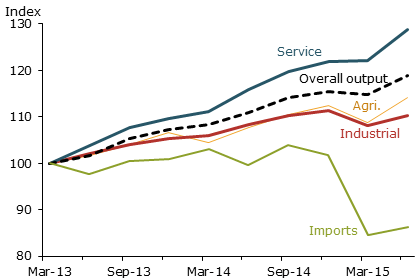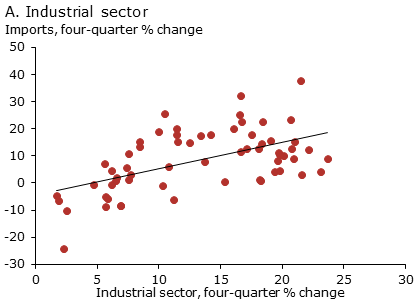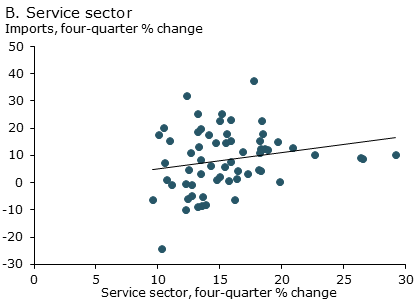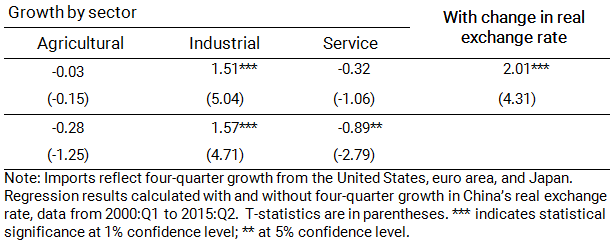China’s demand for imports helps support the global economic recovery, so China’s recent economic slowdown has caused international concern. China’s slowdown is concentrated in the industrial sector, while its emerging service sector has shown much new strength. However, China’s service sector is relatively closed and relies only modestly on imports. Accordingly, service sector growth is unlikely to offset the adverse implications of a slowing China for global trade.
The recent slowdown in China’s economic growth has caused a great deal of concern, particularly among global trade partners that export to China. On November 3, China’s President Xi Jinping announced that expected real GDP growth over the next five years would be no lower than 6.5%, which is one-half percentage point lower than the previous estimate. The industrial sector has been particularly weak as it has expanded by only 0.2% over the past year. In addition, imports to China continue to fall dramatically, as shown in Figure 1. Import values in October 2015 were almost 19% lower than they were in October of the previous year.
Figure 1
China’s sectoral output and total value of imports

Source: CEIC and IMF Direction of Trade Statistics.
Note: Quarterly output levels for agricultural, industrial, and services sectors. Data are indexed to 100 at 2013:Q1 and seasonally adjusted.
However, a number of analysts (for example, Lardy 2015) have argued that concern about the slowdown in the Chinese economy—and the associated reduction in Chinese imports—is overblown. Instead, they point to the resilience in the country’s service sector. This sector has indeed been a source of relative strength, with reported growth of 11.9% over the past four quarters.
In this Economic Letter, I show that the strength of China’s service sector is not likely to provide much support for gross exports from the rest of the world over the short term. The steep recent decline in China’s imports is consistent with the country’s growth pattern across different sectors. There has been a strong positive relationship between slower growth in gross imports and slower growth in industrial output over the past 15 years. However, imports and service outputs do not show a significant relationship. These results hold both for imports from non-commodity exporting advanced economies and for advanced and emerging market economies that export commodities to China. Therefore, from the rest of the world’s point of view, an increase in China’s service sector does not offset a similar magnitude decline in its industrial sector.
Recent sectoral growth patterns
Reports suggest China’s growth slowdown has been relatively moderate to date. However, some people have argued that China’s slowdown may be even steeper than reported, in keeping with long-standing skepticism about official Chinese data. In 2007, current Premier Li Keqiang reportedly said that, rather than looking at officially reported output data, his province’s government focused on alternative indicators, mentioning three: electricity consumption, the volume of rail cargo, and the amount of loans disbursed. He added, “All other figures, especially GDP statistics, are ‘for reference only.’” (Wikileaks 2007).
Since that time, a number of alternative indicators of Chinese activity have been produced (for example, Fernald, Hsu, and Spiegel 2015) based on movements in alternative indicators of Chinese activity that are less prone to manipulation. These indicators suggest lower levels of growth than the officially reported statistics. For example, the Fernald et al. preferred indicator series calculates that Chinese output for the second quarter of 2015 fell short of the officially reported 6.9% growth figure, growing less than 6% over the previous four quarters.
However, some researchers argue that these alternative indicator series are subject to negative bias due to China’s structural transformation emphasizing more domestic demand for services. For example, in a recent New York Times article, Nicholas Lardy (2015) argues that “naysayers” are excessively focused on the weakness in China’s industrial sector and its low electricity consumption. With a greater share of spending now focused on services, Lardy argues, “Assuming that electric power growth is a good proxy for China’s overall economic expansion is like trying to drive a car by looking in the rearview mirror.”
China’s output has indeed tilted towards services over the past five years. The service sector as a share of China’s overall output has increased from about 44% in 2010 to 50% in the latest quarter. The country’s “tertiary” sector, which primarily reflects services, has also been strong relative to other sectors. As shown in Figure 1, the growth in China’s service sector has been much higher than its growth in either the agricultural or industrial sectors, and has moderated the recent overall GDP slowdown to 6.9% growth (black dashed line). Over the past four quarters, the agricultural sector grew 4.8% and the industrial sector grew a mere 0.2%, while the service sector grew a remarkable 11.9%.
Service sector output and imports
While strong service sector growth should mitigate the adverse implications of the steep decline in the industrial sector, it is unlikely to provide much support for China’s imports. The service sector relies much less on imported intermediate inputs than other sectors. The agricultural and industrial sectors use a larger share of these imports than they contribute to total output; by contrast, the service sector accounts for very little international trade, with its share of imports only 0.3 times the size of its share in output.
This pattern has resulted in a close correlation between China’s imports and output growth in its industrial sector, and almost no correlation between imports and service sector growth. Figure 2 shows the relationship between imports and these two sectors from the first quarter of 2000 through the second quarter of 2015. The vertical axis on each panel shows four-quarter growth in imports from a group of non-commodity exporting advanced economies—the United States, euro area, and Japan, which constitute 35–40% of world exports to China. The horizontal axis shows four-quarter output growth in the industrial sector (panel A) and the service sector (panel B).
Figure 2
Changes in China’s imports and sector outputs


Note: Imports are inflation-adjusted change in imports to China from the United States, euro area, and Japan by sector, 2000–2015.
The fitted lines indicate that a relatively strong positive correlation exists between imports from this group of countries and growth in China’s industrial sector, but the relationship between imports and output growth in the service sector is far more tenuous.
To examine this relationship more formally, I conduct statistical regression analysis to determine whether changes in imports move in the same direction as changes in output from each sector. For part of the analysis, I include China’s real exchange rate to check the robustness of the findings, as movements in this rate are likely to influence imports through the terms of trade. I use four-quarter growth data to account for the increase in the relative shares of China’s service sector activity caused by normal business cycle changes over the course of the sample and to avoid seasonality issues.
Regression results in Table 1 represent the sensitivity of growth in Chinese imports to growth in the sector indicated in each column. Asterisks represent statistical significance, as noted in the table. The regression results in the table confirm the patterns in Figure 2. Changes in imports from the group of non-commodity exporting advanced economies are quite sensitive to changes in industrial sector growth and move in the same direction. Given a one-standard-deviation decrease in growth in China’s industrial sector—6.3 percentage points in this sample—imports decline 9.5 percentage points. In contrast, there is a negative but not always statistically significant relationship between imports and growth in the service sector in the base specification. Growth in the agricultural sector does not have a significant impact on Chinese imports.
Table 1
Regression results: Impact on China’s import growth from growth in sectors

Impact of service sector growth on imports from commodity exporting countries
Those concerned about China’s slowdown are also worried that it would adversely affect countries that export commodities to China—particularly some fragile emerging market economies. The concern is that lower demand from China could trigger financial disruptions and currency devaluations in those countries.
I therefore repeat the statistical exercise for other groups of countries that may be negatively affected by a China slowdown. In particular, I concentrate on commodity exporting countries, as China is a key importer of commodities. To identify commodity exporting countries, I use the United Nations Conference on Trade and Development data set and select countries whose net exports excluding trade in food exceed 0.5% of their GDP. I then separate these countries into an advanced economy group, which includes Australia, Canada, Iceland, and Norway, and a much larger group of commodity-exporting emerging market economies, which are listed in the online Appendix, along with detailed regression results for these alternative samples.
Results for these commodity exporting countries are similar and even stronger than for the earlier group. Imports from commodity-exporting emerging markets show significant decreases, moving in the same direction as China’s industrial sector, with an estimated sensitivity of 3.9, more than double the estimate for the group in Table 1, whether or not the real exchange rate is included. Again, import growth from the commodity exporting group of countries falls as service sector growth rises, with a significantly negative coefficient of –1.7 without and –2.1 with the inclusion of the real exchange rate. This negative result is not surprising if the service sector is growing in part at the expense of the import-intensive industrial sector.
For commodity exporting advanced economies, I obtain similar significant and positive coefficient estimates for industrial sector growth, of 1.5 without and 1.6 with the inclusion of the real exchange rate, while service sector growth is insignificant.
Conclusion
The results in this Letter suggest that the steep decline in growth in China’s industrial sector has likely been a prominent reason for the steep recent decline in China’s imports. In contrast, the strength in the service sector is unlikely to provide much support for countries that export commodities to China. From the view of an exporter, a dollar of increased service sector activity is unlikely to fully compensate for a dollar of lost industrial sector output.
One important note is that these results concentrate on gross imports into China. This is an appropriate measure for gauging the immediate disruption of trade patterns from the Chinese slowdown. However, over the medium and longer terms, the changes in Chinese economic activity on net trade patterns should be more important. As China’s economy turns towards serving domestic consumption, it is likely to rely less on exports as its engine of growth and its trade should become more balanced. Therefore, the reallocation of growth towards China’s service sector should have more benign medium-term implications for its trade partners.
Mark Spiegel is a vice president in the Economic Research Department of the Federal Reserve Bank of San Francisco.
References
Fernald, John, Eric Hsu, and Mark M. Spiegel. 2015. “Is China Fudging Its Figures? Evidence from Trading Partner Data.” FRB San Francisco Working Paper 2015-12.
Lardy, Nicholas R. 2015. “False Alarm on a Crisis in China.” New York Times, August 26.
Wikileaks. 2007. “Fifth Generation Star Li Keqiang Discusses Domestic Challenges, Trade Relations with Ambassador,” March 15.
Opinions expressed in FRBSF Economic Letter do not necessarily reflect the views of the management of the Federal Reserve Bank of San Francisco or of the Board of Governors of the Federal Reserve System. This publication is edited by Anita Todd and Karen Barnes. Permission to reprint portions of articles or whole articles must be obtained in writing. Please send editorial comments and requests for reprint permission to research.library@sf.frb.org